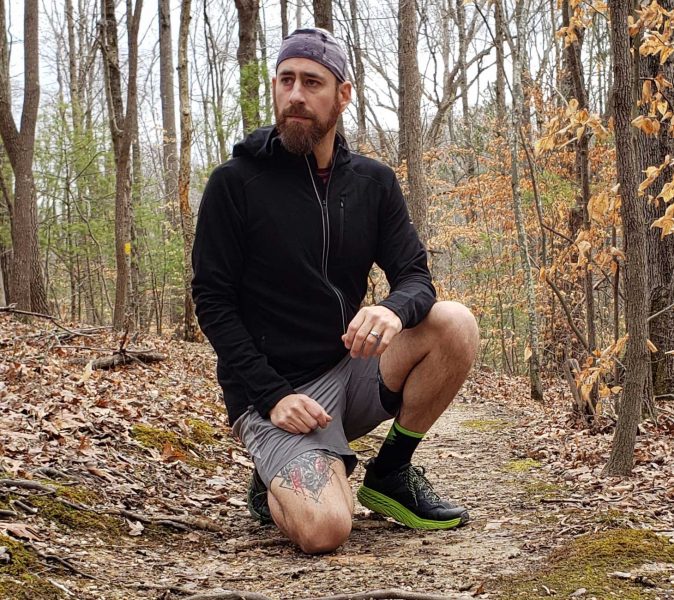
Image by Ryan Tipps
In the world of outdoor gear, each component serves an important role — contributing to your comfort, safety and performance in a variety of environments. Understanding the anatomy of outdoor gear will help you make the best gear choices based on your needs. When you have knowledge of the materials and what those materials do, you can use that knowledge to enhance your outdoor experience.
For example, if you need a bag that can withstand scrapes and drops, you may want to consider canvas or Cordura fabrics. If you need a sleeping bag that will keep you warm in winter weather, you’ll want to understand down fill power and hydrophobic down. And if you’re looking for a shoe that will keep you secure in rocky terrain, you may want to brush up on your knowledge of Vibram soles.
Let’s unpack 25 common fabrics and phrases you’ll commonly see and hear in the outdoor space.
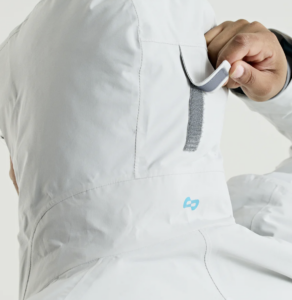
Image courtesy of OROS
Aerogel
Purpose: To keep you warm.
Aerogel is an ultralight and highly insulating material used in outdoor gear to provide warmth without adding bulk. It’s a highly porous (having many tiny empty spaces) solid material derived from a gel. Product engineers replace the liquid component of the gel with a gas. Aerogel is typically composed of silica or other metal oxides — giving the product exceptional thermal insulation properties.
Example product: The OROS Orion Parka uses aerogel insulation to keep you warm in extreme cold.
In the field: While camping in subzero temperatures, wearing a jacket insulated with aerogel ensures that you stay cozy and comfortable without feeling weighed down by bulky layers.
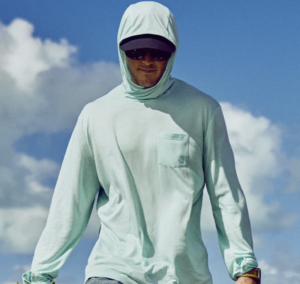
Image courtesy of Free Fly
Bamboo
Purpose: To keep you cool and dry.
Bamboo fabric is soft, moisture-wicking, and eco-friendly, making it ideal for activewear and base layers. Also known as “bamboo viscose” or “bamboo rayon” manufacturers make this fabric from bamboo pulp. The process involves breaking down bamboo into a cellulose pulp, which is then dissolved in chemicals and extruded to create fibers that manufacturers can spin into yarn and weave into fabric. (While bamboo is the primary raw material, the manufacturing process typically involves the use of chemicals, which can vary depending on the specific method used by different manufacturers.)
Example product: Free Fly Bamboo Lightweight Hoodie made of viscose from bamboo and polyester.
In the field: During a long hike on a hot day, wearing a bamboo base layer or outer layer helps keep you cool and dry by wicking away sweat and allowing your skin to breathe.
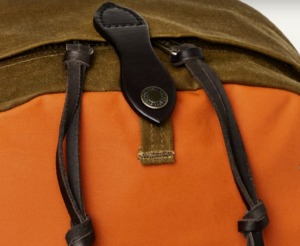
Image courtesy of Filson
Canvas
Purpose: Protection and warmth in rugged environments.
Canvas is a durable, heavy-duty fabric commonly used in backpacks and outdoor clothing for its toughness and longevity. Canvas is traditionally made from cotton, but producers also linen or synthetic fibers like polyester.
Example product: Filson Tin Cloth Backpack, made from rugged canvas with water-resistant wax coating.
In the field: When going on a multi-day backpacking trip, using a canvas backpack ensures that your gear stays protected from rough terrain and unpredictable weather conditions.

Image courtesy of Osprey
Cordura
Purpose: Durability and ruggedness.
Cordura is an abrasion-resistant fabric used in outdoor gear such as backpacks and tents for its durability. To the touch, the fabric typically feels firm and rugged — somewhat like a thick canvas but with a smoother texture.
Example product: Osprey Atmos AG 65 Backpack, featuring Cordura nylon construction.
In the field: While rock climbing, having a backpack made with Cordura fabric ensures that it can withstand scrapes against rough rock surfaces without tearing or wearing out.
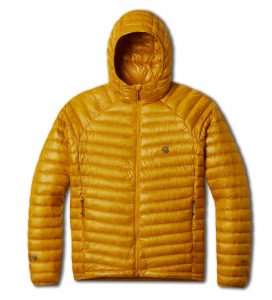
Image courtesy of Mountain Hardware
Down Fill Power
Purpose: Help you measure warmth.
Down fill power measures the loft (the fluffiness and resilience of the down clusters within a jacket or bedding) and insulation capability of down feathers. Higher numbers indicate better warmth-to-weight ratio. For example, an 800-fill power goose down sleeping bag or jacket will be warmer than a 600-fill-power one.
Example product: Mountain Hardwear Ghost Whisperer Down Jacket, filled with 800-fill-power goose down.
In the field: During a chilly morning hike in the mountains, wearing a jacket with high down fill power provides warmth without adding bulk, allowing you to move freely.
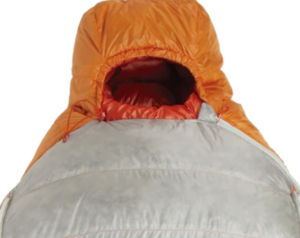
Image courtesy of Big Agnes
Down Tek Hydrophobic Down
Purpose: To keep you dry and warm.
Down feathers treated with a hydrophobic coating to repel water, maintaining loft and insulation even when wet.
Example product: Big Agnes Torchlight UL Sleeping Bag, featuring DownTek water-repellent down insulation.
In the field: While kayaking, using a sleeping bag with DownTek hydrophobic down ensures that you stay warm and dry, even if your gear gets splashed or exposed to moisture.

Image courtesy of Arc’teryx
DWR Coated
Purpose: To repel water.
Durable Water Repellent (DWR) coating is applied to fabrics to make them water-resistant while maintaining breathability.
Example product: Arc’teryx Beta AR Jacket, treated with DWR for waterproof protection in rainy conditions.
In the field: When biking in light rain, wearing a jacket with DWR coating keeps you dry and comfortable without overheating, allowing you to stay focused on the ride.
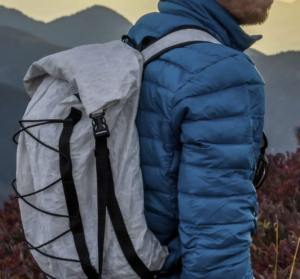
Image courtesy of Hyperlite
Dyneema
Purpose: To protect your gear.
Dyneema is an ultra-high-molecular-weight polyethylene fabric known for its exceptional strength-to-weight ratio, often used in high-performance gear like climbing ropes and backpacks. This fabric typically feels smooth and soft to the touch.
Example product: Hyperlite Mountain Gear Dyneema Summit Pack, made from lightweight and tear-resistant Dyneema Composite Fabric.
In the field: When embarking on a challenging alpine climb, using a backpack reinforced with Dyneema fabric ensures that it can withstand rough handling and abrasion from sharp rocks.

Image courtesy of Patagonia
Elastane
Purpose: To give you comfort through stretch.
Elastane, also known as Spandex or Lycra, is a stretchy fabric used in activewear to provide flexibility and freedom of movement. Manufacturers make elastane from long-chain synthetic polymers called polyurethane.
Example product: Patagonia Men’s R1 Pullover, featuring a blend of polyester and elastane for stretch and mobility.
In the field: While trail running, wearing a shirt with elastane allows for unrestricted movement, ensuring that you can navigate rough terrain with ease.
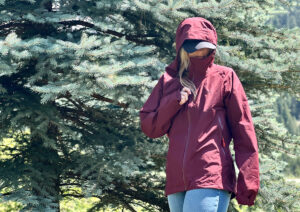
Image by Suzanne Downing
eVent
Purpose: To keep you dry.
eVent is a waterproof and breathable fabric membrane used in outdoor apparel to keep you dry and comfortable in wet conditions.
Example product: Rab Kinetic Plus Jacket, featuring eVent DVStorm fabric for waterproof protection during active pursuits.
In the field: When hiking in heavy rain, wearing a jacket with eVent fabric allows moisture to escape while preventing rain from penetrating, keeping you dry and comfortable throughout the trek.

Image courtesy of The North Face
FutureLight
Purpose: To keep you dry in rain and snow
FutureLight is a breathable, waterproof fabric technology developed by The North Face, designed for high-performance outdoor gear.
Example product: The North Face FutureLight Summit L5 LT Jacket, featuring FutureLight fabric for durable weather protection during mountaineering expeditions.
In the field: When mountaineering in harsh conditions, wearing a jacket with FutureLight technology ensures reliable waterproofing and breathability, allowing you to stay focused on your ascent without worrying about the weather.
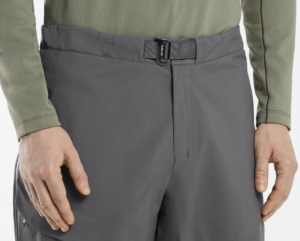
Image courtesy of Arc’teryx
Gore-Tex
Purpose: To provide you with 100% waterproof gear.
Gore-Tex is a waterproof, breathable membrane used in outdoor clothing and footwear to provide protection against rain and snow while allowing moisture to escape.
Example product: Arc’teryx Beta AR Pants, featuring Gore-Tex Pro fabric for durable waterproofing in harsh mountain environments.
In the field: While camping in unpredictable weather, wearing pants with Gore-Tex fabric keeps you dry and comfortable, whether you’re hiking through rain-soaked trails or sitting around a damp campfire.
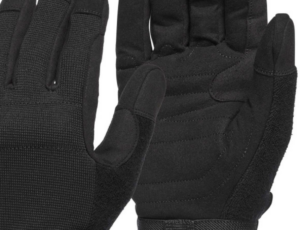
Image courtesy of Black Diamond
Kevlar
Purpose: Protection from rugged terrain and elements.
Kevlar is a high-strength synthetic fiber known for its exceptional toughness and resistance to abrasion, commonly used in outdoor gear for added durability.
Example product: Black Diamond Crag Gloves, featuring Kevlar-reinforced palms for enhanced durability during rock climbing.
In the field: When rock climbing in rugged terrain, wearing gloves with Kevlar-reinforced palms provides extra protection against abrasion from sharp rocks, ensuring long-lasting performance and grip.
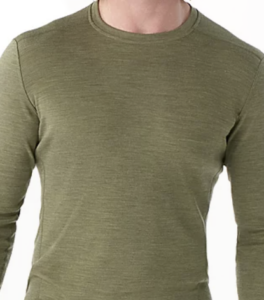
Image courtesy of Smartwool
Merino Wool
Purpose: To keep you comfortable and warm.
Merino wool is a natural fiber known for its softness, moisture-wicking properties, and odor resistance, making it ideal for base layers and socks. Merino wool comes from Merino sheep, which are primarily raised in Australia and New Zealand. These sheep produce a fine and soft wool that is highly prized for its warmth, breathability, and moisture-wicking properties — making it ideal for use in outdoor clothing and gear.
Example product: Smartwool Men’s Merino 250 Base Layer Crew, made from 100 percent Merino wool for warmth and comfort during cold-weather activities.
In the field: While hiking in chilly conditions, wearing a Merino wool base layer keeps you warm and dry by wicking sweat away from your skin, preventing discomfort and chafing during long treks.
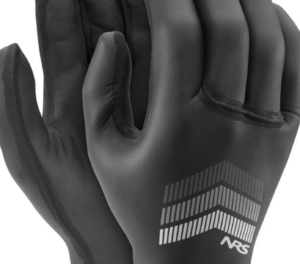
Image courtesy of NRS
Neoprene
Purpose: Give you a waterproof shield.
Neoprene is a synthetic rubber fabric known for its insulating and waterproof properties, commonly used in wetsuits and gloves for water sports. Neoprene typically feels smooth, flexible, and slightly rubbery to the touch.
Example product: NRS Maverick Gloves, made from 3mm neoprene for warmth and dexterity during kayaking and rafting.
In the field: When kayaking in cold water, wearing gloves made from neoprene provides insulation to keep your hands warm and protected from the elements, allowing you to paddle comfortably for extended periods.

Image courtesy of REI
Nylon Ripstop
Purpose: Protect you and your gear from damage.
Nylon ripstop is a lightweight and durable fabric with reinforced grid patterns to resist tearing, commonly used in outdoor gear such as tents and backpacks.
Example product: REI Co-op Quarter Dome SL 2 Tent, featuring nylon ripstop fabric for durability and weather resistance on backpacking trips.
In the field: While camping in windy conditions, using a tent with nylon ripstop fabric ensures that it can withstand gusts without tearing, providing a secure shelter for a restful night’s sleep.
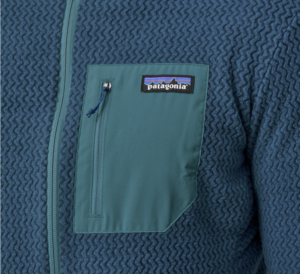
Image courtesy of Patagonia
Polartec Fleece
Purpose: To keep you warm and dry
Polartec fleece is a warm and breathable fabric used in jackets and mid-layers for insulation and moisture management during outdoor activities.
Example product: Patagonia R1 Full-Zip Fleece Jacket, made from Polartec Power Grid fabric for lightweight warmth and breathability.
In the field: When hiking in cool weather, wearing a fleece jacket made from Polartec fabric provides insulation to keep you warm without overheating, allowing you to stay comfortable and focused on the trail.

Image courtesy of Under Armour
Polypropylene
Purpose: To wick away moisture
Polypropylene is a moisture-wicking synthetic fabric often used in base layers and socks to keep skin dry and regulate body temperature during physical activity.
Example product: Under Armour Men’s HeatGear Compression Shirt, made from polypropylene fabric for moisture management and comfort during intense workouts.
In the field: While trail running in hot weather, wearing a base layer made from polypropylene fabric helps wick sweat away from your body, keeping you cool and preventing chafing for a more enjoyable run.
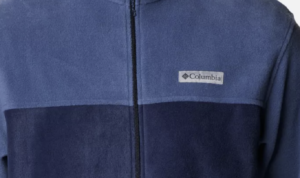
Image courtesy of Columbia
Polar Fleece
Purpose: To keep you comfortable and warm
Polar fleece is a soft and insulating fabric used in jackets, hats, and gloves for warmth and comfort during outdoor adventures.
Example product: Columbia Steens Mountain Full Zip Fleece Jacket, made from polar fleece for cozy warmth on chilly days.
In the field: When biking in cold weather, wearing a fleece jacket provides insulation to keep you warm during long rides, while the soft fabric feels comfortable against your skin, allowing for unrestricted movement.

Image courtesy of Marmot
PrimaLoft
Purpose: To give you a lightweight gear option that keeps you warm.
PrimaLoft is a synthetic insulation known for its lightweight and water-resistant properties, used in jackets, sleeping bags, and gloves for warmth in wet conditions. PrimaLoft is made of ultra-fine polyester fibers, engineered to mimic the structure of down clusters.
Example product: Marmot Trestles Elite Eco 20 Sleeping Bag, insulated with PrimaLoft Silver Eco for lightweight warmth and compressibility on backpacking trips.
In the field: While hiking in damp conditions, using a sleeping bag insulated with PrimaLoft keeps you warm and comfortable, even if the bag gets wet from condensation or rain, ensuring a restful night’s sleep on the trail.
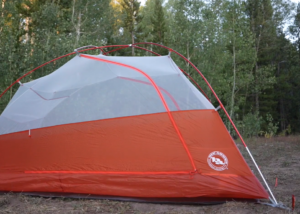
Image courtesy of Big Agnes
Silnylon
Purpose: To protect your gear from weather.
Silnylon is a lightweight and waterproof fabric commonly used in tents and tarps for its durability and weather resistance. short for silicone-coated nylon, is primarily made of nylon fabric that has been impregnated or coated with silicone on both sides.
Example product: Big Agnes Copper Spur HV UL2 Tent, featuring silnylon fabric for reliable waterproofing and wind resistance on backpacking trips.
In the field: While camping in rainy conditions, using a tent made with silnylon fabric ensures that you stay dry and protected from the elements, allowing you to enjoy a comfortable night’s sleep without worrying about leaks or moisture seeping in.
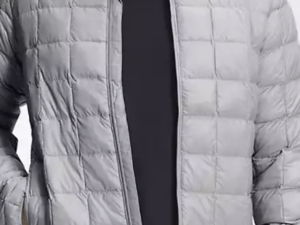
Image courtesy of The North Face
Thinsulate
Purpose: To give you a warm less bulky option.
Thinsulate is a lightweight and low-bulk synthetic insulation used in jackets, gloves, and boots for warmth without added bulk.
Example product: The North Face ThermoBall Eco Jacket, insulated with Thinsulate for lightweight warmth and compressibility.
In the field: While skiing or snowboarding in cold temperatures, wearing gloves insulated with Thinsulate keeps your hands warm and dexterous, allowing you to maintain grip and control on your equipment without sacrificing comfort.
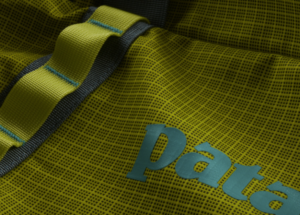
Image courtesy of Patagonia
TPU-film laminate (Patagonia Black Hole Bag)
Purpose: To protect your gear (abrasion resistant).
TPU-film (Thermoplastic Polyurethane) laminate is a durable and waterproof material used in outdoor bags and backpacks for its abrasion resistance and weather protection. This material is often shiny and slick and smooth to the touch.
Example product: Patagonia Black Hole Duffel Bag, featuring a TPU-film laminate for waterproofing and durability during travel and outdoor adventures.
In the field: When traveling or backpacking in wet conditions, using a duffel bag with a TPU-film laminate ensures that your gear stays dry and protected, even in heavy rain or rough handling.
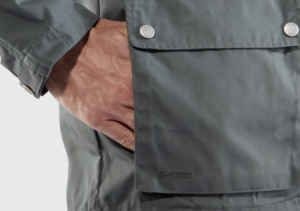
Image courtesy of Fjällräven
Ventile
Purpose: Give you a cotton fabric that repels water.
Ventile is a weatherproof cotton fabric with natural water repellency, often used in jackets and pants for its breathability and comfort in outdoor activities. Ventile fabric is made of 100 percent cotton. It’s densely woven from long-staple cotton fibers, which swell when wet, giving you weatherproofing and durability without the need for additional coatings or laminates.
Example product: Fjällräven Greenland Jacket, made from Ventile fabric for weatherproof protection and durability in outdoor environments.
In the field: When hiking in variable weather conditions, wearing a jacket made from Ventile fabric provides reliable protection from wind and light rain while allowing moisture to escape, keeping you dry and comfortable throughout your hike.

Image courtesy of La Sportiva
Vibram
Purpose: Protection in rugged terrain.
Vibram is a high-performance rubber compound used in the soles of outdoor footwear for superior traction and durability on various terrains. It typically feels like textured rubber.
Example product: La Sportiva TX4 Approach Shoes, featuring Vibram MegaGrip outsoles for grip and stability on rocky trails and technical terrain.
In the field: When hiking or approach climbing on rugged terrain, wearing shoes with Vibram soles ensures confident footing and traction, allowing you to navigate steep slopes and rocky surfaces with ease and security.
Suzanne Downing is an outdoor writer and photographer in Montana with an environmental science journalism background. Her work can be found in Outdoors Unlimited, Bugle Magazine, Missoulian, Byline Magazine, Communique, MTPR online, UM Native News, National Wildlife Federation campaigns and more.
 Your Privacy Choices
Your Privacy Choices
 The
The